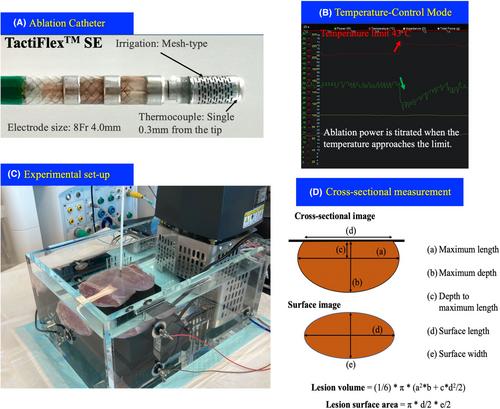An optimized approach for increasing lesion size in temperature-controled setting using a catheter with a surface thermocouple and efficient irrigation
Abstract
Background
We explore an optimized approach for increasing lesion size using a novel ablation catheter with a surface thermocouple and efficient irrigation in a temperature-control setting.
Methods
We conducted radiofrequency applications at various power levels (35 W, 40 W, and 45 W), contact forces (CFs, 10 g/20 g), and durations (60 s/120 s/180 s) in perpendicular/parallel catheter orientations, with normal saline irrigation (NS-irrigation) and Half NS-irrigation (HNS-irrigation) in an ex-vivo model (Step 1). In addition, we performed applications (35 W/40 W/45 W for 60 s/120 s/180 s in NS-irrigation and 35 W/40 W for 60 s/120 s/180 s in HNS-irrigation) in four swine (Step 2), evaluating lesion characteristics and the occurrence of steam pops.
Results
In Step 1, out of 288 lesions, we observed 47 (16.3%) steam pops, with 13 in NS-irrigation and 34 in HNS-irrigation (p = .001). Although steam pops were mostly observed with the most aggressive setting (45 W/180 s, 54%) with NS-irrigation, they happened in less aggressive settings with HNS irrigation. Lesion size significantly increased with longer-duration ablation but not with HNS-irrigation. The optimal %impedance-drop cutoff to predict steam pops was 20% with a negative-predictive-value (NPV) = 95.1% including NS- and HNS-irrigation groups, and 22% with an NPV = 96.1% in NS-irrigation group. In Step 2, similar to the ex-vivo model, lesion size significantly increased with longer-duration ablation but not with HNS-irrigation. Steam pops were absent with NS-irrigation (0/35) even with the largest %impedance-drop reaching 31% at 45 W/180 s. All steam pops were observed with HNS-irrigation (6/21, 29%). The optimal %impedance-drop cutoff predicting steam pops was 24% with an NPV = 96.3% including both NS- and HNS-irrigation groups.
Conclusions
Rather than using HNS-irrigation, very long-duration of radiofrequency applications up to 45 W/180 s may be recommended to safely and effectively increase lesion dimensions using this catheter with NS-irrigation.


 求助内容:
求助内容: 应助结果提醒方式:
应助结果提醒方式:


